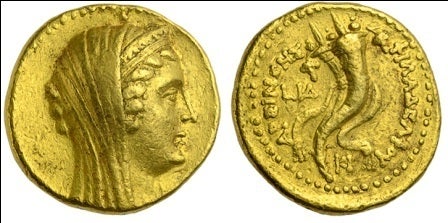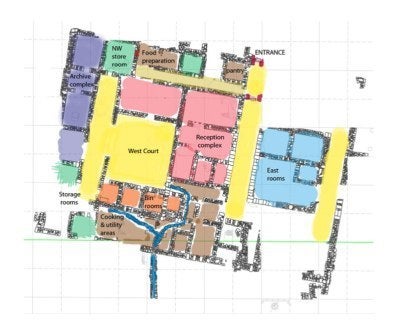2010 was a combined study and excavation season, as we began to prepare in earnest for the final publication of the Persian and Hellenistic Administrative Building (PHAB). The realization in 2009 that the eastern third of the building was not dedicated to domestic space as we had previously assumed required us to make several short, targeted field operations in order to find the entrance of the building during the Hellenistic period and clarify the relationship of various excavated spaces to each other.
The highlight of the season was the discovery of a gold coin during the final phases of cleaning at the end of excavation: the coin, which turned out to be a mnaieion struck by Ptolemy V in 191/190 BCE, was lodged between some stones in the wall of a storage room which was originally excavated in 2000. We think it was stuck there by an ancient administrator or accountant for safekeeping. Like many other objects found at Kedesh over the years, this coin reveals the complex imperial and cultural connections of the site throughout its history – remember, by 190, the PHAB and surrounding territory was under the control of the Seleucid regime of Syria and Mesopotamia, not the Egyptian Ptolemies. This gold coin, made in Cyprus by an Egyptian king (who was the descendant of a Macedonian general) to honor his deified ancestor Arsinoe II (and possibly his new Syrian bride), found its way to Phoenician territory which was itself under the control of an eastern empire. Since the Kedesh mnaieion is the only example of this coin issue known from an excavated archaeological context, it sheds light on imperial processes and contacts in a way that unprovenanced examples can’t.

The mina was the standard unit of weight and currency in the ancient Greek world. This mina coin was worth 100 drachmas. The standard wage for a laborer in the ancient world was one drachma per day, so this coin was worth around a quarter to a third of a standard low to middle class income – the equivalent of around $8,000-$10,000 today.
As spectacular and fascinating as the gold coin is, however, the intellectual focus of 2010, both in excavation and study, was the hundreds of artifacts and thousands of pages of records we’d amassed since 1997. Study season is when the directors and specialists, aided by students, dedicate their time not to finding new things in excavation, but really figuring out what all the prior excavation work means. Which ceramics appear most regularly in which levels, and with what other types of object? Is there a pattern to the types of objects which are found in a particular area of the site which can point to how that area was used? How were doorways constructed throughout the building, and what can they tell us about the architectural history of the site as well as how people experienced the space? These are all questions we asked ourselves during study season as we prepared in earnest to publish the site in order for others to learn from and build on our work here.

Site plan of building during the Hellenistic period, after 2010 excavation and study season, with areas color-coded by use.

